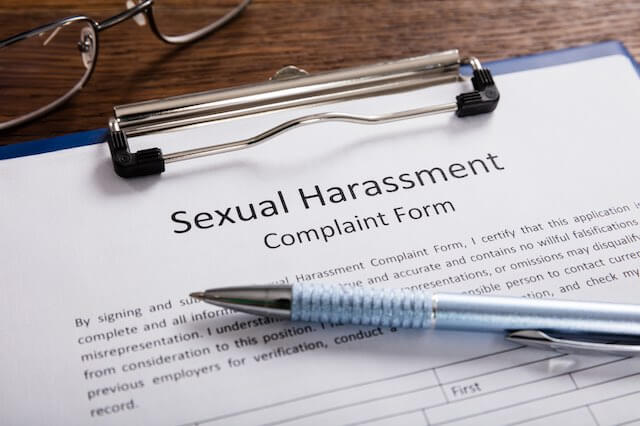With the advent of the Me Too movement, sexual harassment has moved to center stage in several workplace disputes. However, sexual harassment as a violation of law existed long before the Me Too movement. The law hasn’t changed as a result of this new movement; however, an increased awareness of the right for employees to complain about sexual harassment has.
Sexual harassment has always been wrong, but what has changed is that, today, employees may not be as reluctant to raise a claim as in the past. Supervisors, union representatives, and employees should have a basic understanding of what constitutes sexual harassment.
Sexual Harassment as Defined by Law
Sexual harassment is a form of sex discrimination that violates Title VII of the Civil Rights Act of 1964. Title VII applies to employers with 15 or more employees, including state and local governments. It also applies to employment agencies and labor organizations, as well as to the federal government. The law forbids discrimination when it comes to any aspect of employment, including hiring, firing, salary, job discrimination in terms of reassignments, promotions, layoffs, training, fringe benefits, and any other terms or condition of employment.
According to the U.S. Equal Employment Opportunity Commission (EEOC), sexual harassment can occur in a variety of ways:
- The victim, as well as the harasser, can either be a man or a woman—a victim does not have to be of another gender.
- The harasser may be the victim’s supervisor, an agent of the employer, a supervisor in another area, a co-worker, or a non-employee, such as a vendor or customer.
- The victim does not have to be only the person being harassed but could also be anyone affected by the offensive conduct.
- Unlawful sexual harassment may occur without economic injury to, or discharge of, the victim.
- The harasser’s conduct must be unwelcome.
Harassment can include “sexual harassment” or unwelcome sexual advances, requests for sexual favors, and other verbal or physical harassment of a sexual nature.
This includes physical, verbal, or non-verbal conduct of a sexual nature, such as:
- Unwanted sexual attention
- Sexual advances
- Requests for sexual favors
- Sexually explicit comments
- Other conduct of a sexual nature
To be considered sexual harassment, the behavior does not always have to be of a sexual nature. It can also include offensive remarks about a person’s gender. For example, it is illegal to harass a woman by making offensive comments about women in general.
Sexual harassment may be direct or implied and committed by an individual who knows, or reasonably should know, that such conduct is unwanted and offensive. Such conduct can often be considered as:
- Hostile
- Threatening
- Derogatory
- Demeaning
- Abusive
- Intended to insult, embarrass, belittle, or humiliate
Forms and Locations of Sexual Harassment
Sexual harassment can occur in many ways and places. The following are some examples (which should not be considered an inclusive list of prohibited behaviors):
Physical – This not only includes overt, intrusive actions, such as assault or other forms of physical abuse, but also includes more covert actions, such as touching others in areas that are not generally considered appropriate. Passing by someone in the workplace and touching their shoulder might not, in and of itself, be considered inappropriate physical contact; however, consistently engaging in this behavior could meet the definition of inappropriate contact.
Verbal – This can include disparaging remarks about a person’s gender, comments and/or jokes of a sexual nature, requests for sexual favors, or unwelcome sexual advances.
Visual or Non-Verbal – These can include facial expressions, suggestive gestures, leering, or be verbal, such as making sounds or whistling. These can further include displaying or sharing sexually suggestive media in paper or electronic form.
Online or Electronic – Sexual harassment can occur anywhere, such as online or through other electronic platforms. This can include sharing sexually suggestive comments or media through posts in social media platforms, or emailing, texting, and calling, etc.
Offsite – This includes work-related social events, business travel, or unwelcome visits to a person’s home or hotel room.
Examples of Sexual Harassment
Examples of conduct that could be considered sexual harassment:
- Denying an Employment Benefit – Denying (directly or indirectly) an employment benefit or employment-related opportunity to an employee for refusing to comply with a sexually-oriented request.
- Threatening Denial of an Employment Benefit – Threatening (directly or indirectly) to deny an employment benefit or an employment-related opportunity to an employee for refusing to comply with a sexually-oriented request.
- Providing or Promising an Employment Benefit – Providing or promising (directly or indirectly) to provide an employment benefit or employment-related opportunity to an employee in exchange for complying with a sexually-oriented request.
- Engaging in Physical Contact – Engaging in sexually explicit or suggestive physical contact, including touching another employee in a way that is unwelcome or restricts an employee’s movement.
- Displaying or Transmitting Pornography – Displaying or transmitting pornographic or sexually oriented materials, such as photographs, posters, cartoons, drawings, or other images, or storing or accessing such materials on government-owned equipment or employer-owned equipment for personal use or consumption.
- Engaging in Indecent Exposure or Exposing Body Parts to Attract Sexual Attention– Engaging in indecent exposure of body parts usually kept private in order to attract sexual attention. Exposing body parts to attract sexual attention could include a low-cut blouse or tight pants.
- Making Obscene Gestures – Making obscene gestures of a sexually-oriented nature.
- Making Romantic Advances – Making romantic advances toward an individual and persisting, despite rejection of the advances.
- Using Sexually Oriented Language – Using sexually-oriented language or making sexually-related propositions, jokes, or remarks, including graphic verbal commentary about an individual’s body or clothing.
- Sending Sexual Messages – Sending sexually suggestive or obscene messages by mail, in person, telephone, text, or any other electronic communication.
Although the law doesn’t prohibit simple teasing, offhand comments, or isolated incidents that do not form a pattern of conduct, harassment in the workplace is illegal when it is so frequent or severe that it creates a hostile or offensive work environment, or when it results in an adverse employment decision (such as the victim being fired or demoted).




